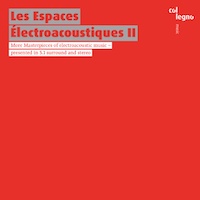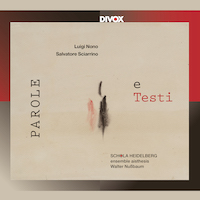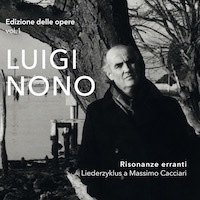Maestro di Suoni e Silenzi: Necessary Nono 5.
|
Grant Chu Covell [May 2022.] Recordings do not always serve these pieces well, but what are we going to do? In recent years we’ve seen a few freshened tapes as well as some serious sorting out of the physical scores. Remember that some of these works changed per the resonance of the performance space. Not that Nono couldn’t make up his mind, just that his compositions gradually became site specific. I’ve set aside a stack to discuss, wanting to go beyond the surface (or attempt to say something profound), but given a few of these have been around for a while, it’s time to get them across the counter and provide some coverage sooner rather than later. Here’s a first group.
“Les Espaces Électroacoustiques II.” Luigi NONO: Omaggio a Emilio Vedova (1960)1; La fabbrica illuminata (1964)2; A floresta é jovem e cheja de vida (1965-66)3. Luciano BERIO: Altra voce (1999)4. Gottfried Michael KOENIG: Klangfiguren II (1955-56)5; Terminus X (1967)6. Karlheinz STOCKHAUSEN: Kontakte (1958-60)7. Sarah Maria Sun2 (sop), Liliana Poli3, Kadigia Bove3, Elena Vicini3, Berto Troni3 (voices), William O. Smith3 (clar), Veniero Rizzardi3, Alvise Vidolin3 (surround mix), Monica Bacelli4 (m-sop), Michele Marasco4 (a-fl), Francesco Giomi4, Damiano Meacci4, Kilian Schwoon4 (live electronics), Johannes Herrmann7 (pno), Lucía Carro Veiga7 (perc), ICST Institute for Computer Music and Sound Technology: Kees Tazelaar6, Carlos Hidalgo7, Germán Toro Pérez2 (sound projection), Florian Bogner1,2,3,4,5,7 (recording, mixing and mastering), Leandro Gianini7 (recording), Germán Toro Pérez (artistic direction). col legno WWE 2SACD 40003 (2 SACDs) (www.col-legno.com). A sequel to a double set (WWE 2SACD 40002) which included classic tape works by Varèse, Ligeti, Maderna, Berio, Lachenmann, Harvey, Boulez and Ferneyhough. Less than five minutes in duration, the tape piece Omaggio a Emilio Vedova is an intense spark. Created in just 20 days, all the sounds are synthetic (exceptional in Nono’s tape oeuvre). The extant tapes are four-track, but back in the 1960’s such a work would have been broadcast in mono, possibly involving mixing. Today’s technology encourages spatial distribution of the four tracks which is what is offered here. Sarah Maria Sun (recorded in 2018) tackles La fabbrica illuminata’s tape enthusiastically. Whether Nono succeeded in bringing the factory into music and music into the factory is a topic for another day. In this rendition, the tape becomes limber and well-articulated as it shifts between slogans and shop noises. This release of A floresta é jovem e cheja de vida gives equal weight to the required tapes and the 1967 recordings of the actors, soprano, clarinet and five copper sheets (1.2mm thick, 132cm x 30cm in size, suspended and struck with chains, mallets, etc.). All the tracks have been remixed. On the mode release (mode 87), the original tapes hover like ghosts behind the new soloists who are more audible. Col legno offers a more consistent surface: Smith’s sounds are deeply embedded in the pre-recorded tracks and his clarinet is less isolated. How do these pieces not end up sounding trite and ringing false? A floresta’s “eleven moments of the anti-imperialist struggle” connote the 1960s whether we hear a performance from the work’s tour or whether today’s players perform against the original tapes. This piece is vigorous, thought through and consistent. Maybe Nono was topical, but he was sincere and honest. This piece (and others like Risonanze erranti) still stand up. This is the first recording of Berio’s Altra voce, an elaborated extract from the 1999 “azione musicale” Cronaca del Luogo. Recorded in 2001, alto flute and mezzo-soprano are looped and layered, representing lovers. Live piano and percussion take big swings within Stockhausen’s Kontakte. The cosmic electronic snoring sound (just after 17:00) is impressive here. Koenig’s through-composed Klangfiguren II and abrasive Terminus X are assertively remixed, boldly etching details.
“Parole e testi.” Salvatore SCIARRINO: L’alibi della parola (1994)1; Tre canti senza pietre (1999)2. Luigi NONO: Polifonica – Monodia – Ritmica (1951; orig. reconstr. vers.)3; Sarà dolce tacere (1960)4; Polifonica – Monodia – Ritmica (1951; vers. H. SCHERCHEN, 1951)5. Schola Heidelberg1,2,4, ensemble aisthesis3, Walter Nußbaum1,2,3,4 (cond.), Musicians of the Darmstadt Federal Theater Orchestra5, Hermann Scherchen5 (cond.). Divox CDX-21701 (1 CD) (www.divox.com). Despite the generational differences, aesthetic ties unite these two Italians. Do not forget that Nono dedicated La lontananza to Sciarrino. The three a cappella works reveal their composers exploring new techniques to manipulate texts. Nono’s Sarà dolce tacere is an eight-part madrigal (two SATB quartets) setting Cesare Pavese. The text is fractured, scored syllable by syllable. Rarely does any one singer carry an entire word. Continually changing pitches and pulse prevent straightforward continuity. This release offers the first recording of a new “old” version of Polifonica – Monodia – Ritmica. When Scherchen premiered the work on July 10, 1951, he drastically pruned away more than six minutes from the first movement and roughly four minutes from the second. What did Scherchen see in the 26-year-old Nono? The succinct form emphasizes the composer’s spiky serialism, pointing towards the dramatic dynamics and rage of the middle-period political works (the published score, Ars Viva Verlag AV 76, reflects the conductor’s edits). Extensive detective work unearthed Nono’s longer original. The rediscovered version opens quietly, less aggressively. Polifonica (10:52 vs. Scherchen’s 4:39) awakens naïvely, the eventual percussive rhythms are strident. Nono’s original was more organically designed, though not as ambitious. This disc includes the 1951 premiere’s recording (with generous audience noise) which permits comparison with the “pre-world-premiere” reconstruction. Sciarrino’s L’alibi della parola is for four male voices. Tre canti senza pietre requires a mixed chorus of seven. Texts and syllables become secondary to precise breathing and razor-sharp articulation. L’alibi della parola demands expressive precision. A tight clutch of catastrophic novellas, Tre canti senza pietre offers meticulously positioned syllables, melismas and whispered echoes. Chorus music is not my thing, but Nono and Sciarrino do wonderful things here.
“Edizione delle opere, vol. 1.” Luigi NONO: Two performances of Risonanze erranti. Liederzyklus a Massimo Cacciari (1986; rev. 1987)1,2. Ensemble Prometeo1: Katarzyna Otczyk1 (c-alt), Mario Caroli1 (fl), Gianluigi Paganelli1 (tba), Flavio Tanzi1, Aurelio Scudetti1, Pietro Pompei1, Alberto Toccaceli1, Sara De Cicco1, Pedro Perini1 (perc), Marco Angius1 (cond.), Luca Richelli1 (electronics), Alvise Vidolin1 (sound projection), Susanne Otto2 (c-alt), Roberto Fabbriciani2 (fl), Giancarlo Schiaffini2 (tba), Carlos Beresi2, Konrad Graf2, Richard Lepetit2, Isao Nakamura2, Rüdiger Pawassar2, Gregory Riffel2 (perc), Friedrich Goldmann2 (cond.), EXPERIMENTALSTUDIO der HSS des SWF2 (electronics), Luigi Nono2, Hans-Peter Haller2 (sound projection). Shiiin ELN1 (1 SACD) (www.shiiin.com). Here are two performances of a large chamber work with texts by Herman Melville and Ingeborg Bachmann, but also incorporating a few phrases from Ockeghem, Desprez and Machaut. The newer recording1 is from 2014 (Parma, October 5, 2014) and the older performance2 is the world premiere of the definite version from 1987 (Paris, October 8, 1987). This big-little piece asks for a contralto, flute (piccolo and bass flute), tuba, and a percussion sextet playing Sardinian bells, crotales and bongos, but also some complicated live electronic processing. Runtime is about 40 minutes (41:00 for Parma, 2014, and 38:14 for Paris, 1987) and consists of 31 small sections where the isolated words are delivered slowly, colored by equally deliberate flute and tuba, and punctuated by bell and drum outbursts. This is a tricky one to enjoy objectively. With the grumbling bells, disjointed texts and pointillistic high (flute) and low (tuba) effects, Risonanze erranti can slide uncomfortably into parody. Structurally there’s a lot going on, and the details welcome close investigation. Similar layered percussive effects appear in Prometeo and A Carlo Scarpa, architetto, ai suoi infiniti possibili, but on the surface, bells and drums also sound like mystical bumbling. (Note that with its tuned crotales and ring-modulated pianos, Stockhausen’s Mantra can also leave this impression.) The Paris label Shiiin which concentrates on electroacoustic music (much Radigue, some Ferrari) suggests this is the first of a series.
[Previous Article:
Used Bin Troll Tweets HHH.]
[Next Article:
Pièces de Clavecin 14. / Italian Vacation 16.]
|


